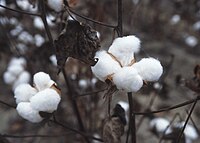Valledupar
The city lies between the mountains of the Sierra Nevada de Santa Marta and the Serranía del Perijá to the borders of the Guatapurí and Cesar rivers.During the 1980s, 1990s and early 2000s, the city suffered during the Colombian Armed Conflict, with numerous kidnappings,[3] thousands of people forced out[4] and failure to control crime.Notable geographic features in Valledupar include the Sierra Nevada de Santa Marta's peaks; the Codazzi, El Guardian, the Ojeda and La Reina.Many rivers descend from its snowy peaks and lagoons; the Ariguani, Ariguanicito, Badillo, Calderas, Cesar, Curiba, Donachui, Garupal, Guatapuri, which borders the city of Valledupar; and the Mariangola.The municipality is home to numerous endemic species, mostly living in the ecosystem of the Sierra Nevada de Santa Marta and Serrania del Perijá mountains, one of the most biodiverse places in the world.The most recently discovered species of bees was found in rural areas of Valledupar and named Stelis vallenata in tribute to the local Vallenato music.During the colonial period, Spaniards introduced invasive European fauna into the region, such as dogs, cats, rats, mice, cattle, horses, mules, goats and gallineta africana, doves, among others.Spaniards traveled through the area and established extensive farming, mainly rearing imported European cattle (among many animals) and agriculture.The region started developing quickly due to political support from the former President Alfonso López Michelsen, first governor of the Department of Cesar's and the Colombian Liberal Party.Valledupar came to be known as sorpresa caribe (the Caribbean surprise) because of its rapid economic growth during the 1970s, especially in cotton production, which local people called "white gold".He began kidnapping (and sometimes killing) prominent political leaders, journalists and rich land owners (including members of his own family), using the ransoms to finance his organization.[9] To counter FARC and ELN's abuses, and after approximately fifteen years of asphyxiating Valledupar's society and supporting negligence by the Colombian military, some prominent leaders of Valledupar, landowners and those victims of these organizations decided to become part or promote, self-defense forces that later on affiliated with the AUC and assigned another "Vallenatean" as leader Rodrigo Tovar Pupo a.k.a.The AUC helped take back the region from guerrillas, but Valledupar residents had to deal with similar uncertainty in having an illegal and terrorist organization controlling the city.See more: Political System of Colombia In Valledupar 84% of the total population lives in the urban areas of the municipality with a density of approximately 68,4 inhabitants per km² (1).The Vallenato music has been a creole fusion of these three cultures; the European accordion, the African drum and percussive elements, and the "guacharaca" from the Amerindians.The economy of Valledupar is based primarily on commerce, retail and banking in the urban area, mainly in the service industry and tourism during the four-day Vallenato Legend Festival.Since the late 20th century, the city has benefited from the department of Cesar's development of coal mining in the region of La Jagua de Ibirico and El Paso.This effort is to promote coffee produced by the local small and medium-sized farms from the Sierra Nevada de Santa Marta and the Serranía del Perijá.The holy week, in April, is celebrated in much the same way as during colonial times; with fasting, church attendance and processions to venerate Jesus and the Santo Eccehomo.Traditional oral storytelling has helped preserve stories, myths and legends, such as the popular "legend of the guatapuri mermaid", or the "silborcito" (the nazarenian without a head), "the Lerta" ("The duel between the devil and Francisco 'the man'"), "the monitos", "The llorona (the crying woman)", "la madre monte (mother nature)" "la mano pelua (the hairy hand)", and "el cuco", among other stories that are still alive.Notable international players include Humberto Osorio Botello, who played for Real Valladolid in the Spanish Primera División.Martial arts (taekwondo, judo and karate), cycling, roller skating, basketball, softball, volleyball, and athletics are also practiced under the support of INDUPAL.Valledupar native Oscar Muñoz won a bronze medal in taekwondo during the 2012 Summer Olympics in London while competing for Colombia.Sports venues include the Armando Maestre Pavajeau Stadium (set to be remodeled), and the Coliseo Cubierto de Valledupar.In the urban area transportation services are provided by taxis, and by private and government bus companies covering the entire city by shared routes.Lately, a new form of transportation was born, informal Auto rickshaws (mototaxismo), taking illegally over the bus and taxi services, to a point that are making them go bankrupt.The local government is attempting to penalize the use of Auto rickshaw for safety reasons and are also operating illegally, but because there are so many and tend to violently protest, the issue became difficult.










MunicipalityColombiaRegionCaribbeanDepartmentpartido ConservadorDemonymTime zoneUTC-05Eastern Time ZoneArea codeClimateCesar DepartmentAmerindiancaciqueSierra Nevada de Santa MartaSerranía del PerijáGuatapurícattle raisingLa Guajira DepartmentvallenatoVallenato Legend FestivalColombian Armed Conflictvariety of environmentsRiohachaSan Juan del CesarLa GuajiraEl PasoLos Robles La Pazdepartment of CesarAracatacaMagdalenaArhuacosSierra Nevada de Santa Marta National ParkTurpialparrotsgallineta africanaYellow TabebuiaEl NiñoLa Niñahailstormsprecipitationrelative humiditysunshine hoursInstituto de Hidrologia Meteorologia y Estudios AmbientalesHistory of ValleduparChimilaAmbrosius EhingerHernando de SantanaEpiphanythree kingsCabildoMaría Concepción LoperenaSimón BolívarFederal State of MagdalenaUnited States of ColombiaBogotáAlfonso López MichelsenColombian Liberal Partythe Patriotic Union (U.P.)Simón Trinidadthe national bank El Banco de la Republica (Bank of the Republic) was robbedRodrigo Tovar PupoJorge 40drug traffickingaccordionguacharacaPolitics of ValleduparcomunasbarriosCorregimientosVeredasAtanquezLos HaticosBadilloPatillalValencia de JesúsEducation in ColombiaColegio Gimnasio del NortePopular University of CesarAmerindiansTaironaArhuacoKankuamoAgricultureoil palmtobaccocoffeecoal miningLa Jagua de Ibiricocattleillegal drug tradeillicit drugsmarihuanafishingtransportationconstructionelectricitycommercegovernmentreal estateeducationhealthcaredomestic servicestourist industryecotourismhospitality industryFederación Nacional de Cafeteros de ColombiacumbiaCastilian SpanishSanto EccehomoCorpus ChristiTecoma chrysostrichastorytellinglegendsminstrelsBarranquilla's CarnivalShopping CenterSubwayJuan Valdez CaféCarrefourCinemarkfootball (soccer)Valledupar FCCopa ColombiaCategoría Primera A